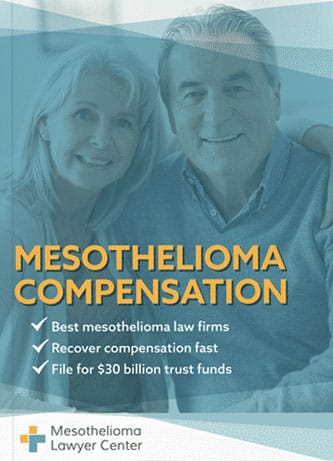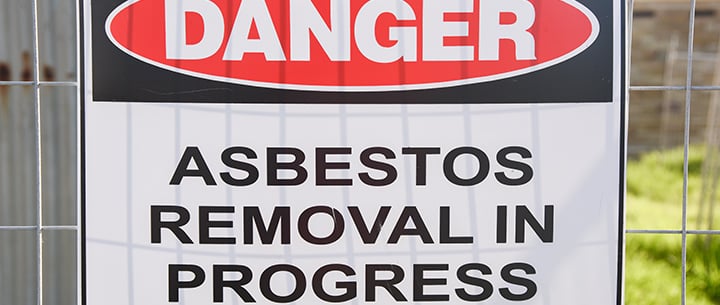Safe asbestos abatement is the removal of asbestos materials that could cause exposure and illnesses, like mesotelioma maligno. Asbestos abatement is regulated by federal, state, and local laws. Always hire a licensed professional to inspect, test, and remove asbestos.
Si padece mesotelioma, cáncer de pulmón relacionado con el asbesto o asbestosis, podría tener derecho a una indemnización considerable. Actualmente, existen más de 1.400 millones de dólares en fondos fiduciarios para el asbesto creados para quienes han sido diagnosticados con una enfermedad relacionada con el asbesto. FComplete nuestro formulario para obtener un Paquete de Compensación Financiera gratuito. Aprenderá sobre los abogados con experiencia en mesotelioma en su área, cómo recibir su pago en 90 días, cómo presentar una reclamación a los fondos fiduciarios de asbesto y más.


Paquete de compensación financiera GRATUITO
- Información sobre despachos de abogados que recuperarán su INDEMNIZACIÓN MÁS ALTA
- Aprenda cómo cobrar en 90 días
- Solicite su parte de $30 mil millones en fondos fiduciarios

The Dangers of Asbestos and Exposure
Amianto is a natural but harmful mineral. It has long been mined and used in multiple industries, primarily as an insulator. In the U.S., asbestos was heavily used in construction. As a result, many buildings today still contain older asbestos materials.
When asbestos is properly contained, it poses little risk. When asbestos is disturbed by repairs, renovations, demolition, or simply deteriorates over time, it becomes dangerous.
Disturbed asbestos releases tiny fibers that anyone in the area can inhale or even ingest. Inside the body, asbestos fibers cause damage to tissue and cells. In some people, exposición al amianto causes illnesses years later:
- Mesotelioma
- cáncer de pulmón
- Asbestosis
- Other respiratory illnesses
Safe asbestos abatement is necessary to minimize the risk of disturbing asbestos materials in buildings and causing exposure.
About Asbestos Abatement
Asbestos abatement isn’t always necessary if you find asbestos in your home. Even if an inspector says abatement is unnecessary, you can hire a professional to do it anyway for peace of mind. But keep in mind that abating asbestos poses its own risks. It is often safer to leave secure asbestos in place.
What Is Asbestos Abatement?
Asbestos abatement is the safe, professional removal of asbestos from a building. Abatement is often the last option in dealing with asbestos in the home. Disturbing asbestos can be more dangerous than leaving it alone in certain situations.
Before deciding to remove asbestos in your home, listen to the advice of a professional, licensed inspector.
How to Hire an Asbestos Abatement Company
Asbestos abatement should only be done by licensed professionals. They are trained to complete the job safely and are licensed by the state to ensure they have met training and safety requirements. Never try to remove asbestos from your home, and never hire a professional who is not licensed.
Keep these tips and considerations in mind when hiring an asbestos abatement professional:
- It’s best to hire different companies for asbestos inspection and removal. This prevents conflicts of interest.
- Request licensing credentials before hiring a company. It’s also a good idea to check with local agencies and the Better Business Bureau to find out if a company has committed any safety violations or has any legal actions against them.
- The company should give you a written contract detailing the project plan and how it adheres to federal and state asbestos regulations.
- Talk to the company about their cleanup plan. Residual asbestos fibers from an abatement project pose a serious risk. They should follow best practices, including wetting asbestos materials and using HEPA vacuums to clean the area.
Where Is Asbestos in Homes?
While asbestos is very harmful to human health, having it in your home does not necessarily pose an urgent risk. Asbestos becomes dangerous when it deteriorates or is damaged.
If you have asbestos in good condition in your home, it is safe to leave it alone. Some of the areas, materials, and products in your home that might contain asbestos include:
- Boilers, pipes, and duct insulation
- Vinyl flooring and adhesives
- Cement sheet, paper, and millboard insulation around furnaces or woodburning stoves
- Gaskets in woodburning stoves and furnaces
- Joint compounds and patching materials
- Textured pains
- Spray-on soundproofing or decorative material
- Roofing and siding shingles
- Artificial embers used in gas fireplaces
- Stovetop pads
The safest way to manage these asbestos materials in good condition is to leave them alone. Asbestos materials become dangerous when disturbed or damaged. This is when they can release harmful fibers.
When Is it Important to Test for Asbestos in the Home?
Many homes do not contain asbestos and never need to test for it. It can be difficult for non-professionals to identify materials in their homes that might contain asbestos. Consider testing for asbestos in these situations:
- Your house was built before 1980, and you don’t know if it contains asbestos materials.
- You are planning to do some home remodeling or renovations.
- A disaster has damaged your home, damaging materials that might contain asbestos.
- You find old, crumbling materials in the home that have deteriorated over time and that might contain asbestos.
Testing for Asbestos in the Home
Many, but not all, homes constructed before the 1980s contain asbestos in these materials. The only way to be certain you have asbestos is to have a professional confirm its presence.
Licensed asbestos professionals perform visual inspections of suspected asbestos materials. They then remove small samples to send to a lab for testing. Lab workers examine the samples and determine the asbestos content in them.
What if I Have Damaged Asbestos in the Home?
Disturbed asbestos materials are dangerous. If you find damaged materials in the home that you suspect might contain asbestos, follow these steps:
- Keep as many people out of that area as possible, including all children.
- Limit activity in that area of the home.
- Leave the materials alone. Avoid sweeping or vacuuming.
- If you can close off the area, do so.
- Call an inspector or abatement professional immediately.
If you have asbestos, the professional inspector will recommend next steps. If it is encapsulated, they will likely recommend leaving it in place and avoiding disturbing it.
If the asbestos is damaged, they can recommend encapsulation or abatement. Encapsulation means sealing the material to bind asbestos fibers together. This prevents them from releasing and causing harm.
What Happens During Asbestos Abatement Projects?
The first step in asbestos abatement is to hire an inspector. Once the inspector confirms the presence of asbestos, an abatement team takes over with the following steps:
- The abatement professional surveys the area to create a plan for removing asbestos materials.
- The team establishes a work area and prepares it for safe removal.
- They enclose the area with plastic sheeting to create a seal and post warning signs outside. They also cover anything in the work area that will not be abated.
- The team sets up negative air pressure units to further prevent asbestos fibers from leaving the work area and contaminating the rest of the house or the outdoors.
- They then wet all asbestos materials to keep fibers from becoming airborne.
- The abatement team removes asbestos materials and seals them in approved, air-tight containers. The containers are also leak-proof, as the asbestos materials should be wet when contained.
- Specially designated vehicles take the containers to a landfill qualified to handle asbestos waste.
- The asbestos team cleans the work area using wet wipes and HEPA filter vacuums.
- The team removes and disposes of their protective clothing and plastic used to seal the area.
Asbestos Today
According to the September 2004 issue of the American Journal of Respiratory and Critical Care Medicine, asbestos is still a threat to over a million U.S. workers. Workers today at the greatest risk of exposure are trabajadores de la construcción and those who repair and maintain equipment and buildings with asbestos.
Although most buildings and structures built after the 1980s do not contain asbestos, there is still a small possibility that some may.
Further, asbestos is still in many imported and aftermarket automotive products, such as brake pads, clutches, and gaskets. These put mechanics and hobbyists at risk of exposure.
If you have been exposed to asbestos, contact a mesothelioma lawyer to learn about your rights and legal options. You could be entitled to compensation.
Getting Legal Help for Exposure to Asbestos
No olvides rellenar nuestro formulario para obtener nuestro regalo gratis. Paquete de compensación financiera, lleno de información sobre los abogados con experiencia en asbesto y mesotelioma en su área. Para obtener ayuda adicional, contáctenos en 800-793-4540.

Pablo Danziger
Revisor y editorPaul Danziger creció en Houston, Texas, y se licenció en Derecho en la Facultad de Derecho de la Universidad Northwestern en Chicago. Durante más de 25 años, se ha dedicado a representar a víctimas de mesotelioma y a otras personas afectadas por la exposición al asbesto. Paul y su bufete han representado a miles de personas diagnosticadas con mesotelioma, asbestosis y cáncer de pulmón, obteniendo indemnizaciones significativas para los clientes lesionados. Cada cliente es fundamental para Paul y atenderá todas las llamadas de quienes deseen hablar con él. Paul y su bufete se encargan de casos de mesotelioma en todo Estados Unidos.
Conéctese con el abogado especializado en mesotelioma Paul Danziger
Referencias
- U.S. Environmental Protection Agency. (2023, August 8). Asbestos Laws and Regulations.
Recuperado de: https://www.epa.gov/asbestos/asbestos-laws-and-regulations - Agency for Toxic Substances and Disease Registry. (2023, May 19). Asbestos Toxicity. Where is Asbestos Found?
Recuperado de: https://www.atsdr.cdc.gov/csem/asbestos/where_is_asbestos_found.html - Agency for Toxic Substances and Disease Registry. (2023, May 19). Asbestos Toxicity. What Are U.S. Standards and Regulations for Asbestos Levels?
Recuperado de: https://www.atsdr.cdc.gov/csem/asbestos/standards_and_regulations.html - U.S. Consumer Product Safety Commission. (n.d.). Asbestos in the Home.
Recuperado de: https://www.cpsc.gov/safety-education/safety-guides/home/asbestos-home
